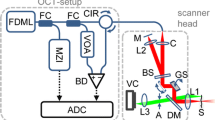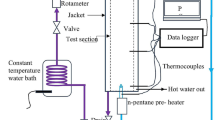Abstract
In this study, we successfully utilize the microscale schlieren method to visualize the microscale mass transport near the vapor–liquid interface during boiling of 2-propanol/water mixtures in a square capillary. Because the variation in the refractive index with composition is much greater than that with temperature, the microscale schlieren method proves to be a powerful tool for investigating the solutocapillary convection without the interference of thermocapillarity. When the difference between the equilibrium vapor and liquid mole fractions is large, we observe high concentration gradients near the vapor–liquid interface due to both mass diffusion and the solutocapillary effects. Although the solutocapillary convection is decidedly affected by the eruptive nature of the boiling process, the near-bubble mass transport still plays a vital role in boiling heat transfer. In a square capillary of d = 900 μm, mass diffusion dominates and the depletion of 2-propanol near the vapor–liquid interface increases. This leads to an increase in the local bubble point causing the deterioration of heat transfer for 2-propanol/water mixtures. However, in the smaller square capillary of d = 500 μm, the solutocapillary effect becomes more important. The induced convection near the contact line helps to augment the boiling heat transfer at x = 0.015, despite the fact that mass diffusion tends to cause a higher concentration gradient normal to the bubble front during the boiling process. Herein, we prove that the microscale schlieren method is able to provide valuable insight into the leverage between different mechanisms in heat transfer during the vaporization process of 2-propanol/water mixtures in a square capillary.








Similar content being viewed by others
Abbreviations
- d :
-
Inner dimension of the square capillary
- D :
-
Mass diffusion coefficient
- h :
-
Heat transfer coefficient
- I :
-
Intensity
- k :
-
Thermal conductivity
- l :
-
Radial distance between the interface and the center of the Marangoni vortex
- M :
-
Molar mass
- Ma :
-
Marangoni number
- n :
-
Refractive index
- q″:
-
Input heat flux
- R i :
-
Radius of curvature of the vapor–liquid interface
- T :
-
Temperature
- ΔT h :
-
Superheat
- t :
-
Thickness
- V :
-
Molar volume
- v :
-
Velocity
- X :
-
Cartesian coordinate along the capillary tube
- x :
-
Liquid mole fraction of 2-propanol in water
- Y :
-
Cartesian coordinate perpendicular to the heating wall
- y :
-
Vapor mole fraction of 2-propanol in water
- Z :
-
Cartesian coordinate opposite to the gravity direction
- θ :
-
Azimuthal angle in the spherical coordinate
- μ :
-
Viscosity
- ρ :
-
Density
- σ :
-
Surface tension
- az:
-
Azeotrope
- bp:
-
Bubble point
- d:
-
Dew point
- g:
-
Borosilicate glass
- i:
-
Vapor–liquid interface
- ideal:
-
Ideal
- l:
-
Liquid
- s:
-
Heated wall of the capillary
- ss:
-
Stainless steel ANSI 304
- v:
-
Vapor
- 0:
-
Reference
- 1:
-
More volatile component of the binary mixture, 2-propanol
- 2:
-
Less volatile component of the binary mixture, water
- ||:
-
Direction parallel to the vapor–liquid interface
- ⊥:
-
Direction normal to the vapor–liquid interface
References
Abbate G, Bernini U, Ragozzino E, Somma F (1978) The temperature dependence of the refractive index of water. J Phys D Appl Phys 11:1167–1172
Abe Y, Oka T, Mori YH, Nagashima A (1994) Pool boiling of a non-azeotropic binary mixture under microgravity. Int J Heat Mass Transf 37:2405–2413
Ahmed S, Carey VP (1998) Effects of gravity on the boiling of binary fluid mixtures. Int J Heat Mass Transf 41:2469–2483
Carey VP (2008) Liquid–vapor phase-change phenomena: an introduction to the thermophysics of vaporization and condensation processes in heat transfer equipment, 2nd edn. Taylor & Francis, New York
Chan SH, Võ D, Nguyen TQ (2010) Sub-pixel motion estimation without interpolation. In: IEEE conference on acoustics, speech and signal processing. Dallas, TX, pp 722–725
Choi B-D, Han J-W, Kim C-S, Ko S-J (2007) Motion-compensated frame interpolation using bilateral motion estimation and adaptive overlapped block motion compensation. IEEE Trans Circuits Syst Video Technol 17:407–416
Cooper MG, Lloyd AJP (1969) The microlayer in nucleate pool boiling. Int J Heat Mass Transf 12:895–913
Dhavaleswarapu HK, Chamarthy P, Garimella SV, Murthy JY (2007) Experimental investigation of steady buoyant-thermocapillary convection near an evaporating meniscus. Phys Fluids 19:082103
Fujita Y, Bai Q (1997) Critical heat flux of binary mixtures in pool boiling and its correlation in terms of Marangoni number. Int J Refrig 20:616–622
Hargather MJ, Lawson MJ, Settles GS, Weinstein LM (2011) Seedless velocimetry measurements by schlieren image velocimetry. AIAA J 49:611–620
Hein M, Wieneke B, Seemann R (2013) Direct calculation of depth of correlation and weighting function in mPIV from experimental particle images. In: 10th international symposium on particle image velocimetry. Delft, Netherlands
Heitz D, Mémin E, Schnörr C (2010) Variational fluid flow measurements from image sequences: synopsis and perspectives. Exp Fluids 48:369–393
Heller W (1965) Remarks on refractive index mixture roles. J Phys Chem 69:1123–1129
Hildebrand FB (1992) Methods of applied mathematics, 2nd edn. Dover Publications, Mineola
Irani M, Peleg S (1993) Improving resolution by image registration. CVGIP Graph Models Image Process 53:231–239
Ishibashi E, Nishikawa K (1969) Saturated boiling heat transfer in narrow spaces. Int J Heat Mass Transf 12:863–894
Itoh K (1982) Analysis of the phase unwrapping algorithm. Appl Opt 21:2470
Knauer OS, Lang MC, Braeuer A, Leipertz A (2010) Simultaneous determination of the composition and temperature gradients in the vicinity of boiling bubbles in liquid binary mixtures using one-dimensional Raman measurements. J Raman Spectrosc 42:195–200
Liu C, Zeng A, Yuan X, Yu G (2008) Experimental study on mass transfer near gas-liquid interface through quantitative schlieren method. Chem Eng Res Des 86:201–207
McGillis WR, Carey VP (1996) On the role of Marangoni effects on the critical heat flux for pool boiling of binary mixtures. J Heat Transf 118:103–109
McGrew JL, Bamford FL, Rehm TR (1966) Marangoni flow: an additional mechanism in boiling heat transfer. Science 153:1106–1107
Merzkirch W (1974) Flow visualization. Academic Press, New York
Okhotsimskii A, Hozawa M (1998) Schlieren visualization of natural convection in binary gas-liquid systems. Chem Eng Sci 53:2547–2573
Olsen MG, Adrian RJ (2000) Out-of-focus effects on particle image visibility and correlation in microscopic particle image velocimetry. Exp Fluids 29:S166–S174
Passos JC, Possamai LFB, Hirata FR (2005) Confined and unconfined FC72 and FC87 boiling on a downward-facing disc. Appl Therm Eng 25:2543–2554
Poling BE, Prausnitz JM, O’Connell JP (2000) The properties of gases and liquids, 5th edn. McGraw-Hill, New York
Raake D, Siekmann J (1989) Temperature and velocity fields due to surface tension driven flow. Exp Fluids 7:164–172
Savino R, di Francescantonio N, Fortezza R, Abe Y (2007) Heat pipes with binary mixtures and inverse Marangoni effects for microgravity applications. Acta Astronaut 61:16–26
Settles GS (2001) Schlieren and shadowgraph techniques, 2nd edn. Springer, New York
Sha Y, Li Z, Wang Y, Huang J (2012) The Marangoni convection induced by acetone desorption from the falling soap film. Heat Mass Transf 48:749–755
Stephan K (1992) Heat transfer in condensation and boiling. Springer, Berlin
Stoica V, Stephan P (2007) Phase shift interferometry for accurate temperature measurement around a vapor bubble. Exp Heat Transf 20:261–275
Straub J (1995) The micro wedge model: A physical description of nucleate boiling without external forces. In: Proceedings of the 9th European symposium on gravity-dependent phenomena in physical sciences (Berlin, Germany)
Sun C-l, Hsiao T-h (2013) Quantitative analysis of microfluidic mixing using microscale schlieren technique. Microfluid Nanofluid 15:253–265
Tasić AŽ, Djordjević BD, Grozdanić DK, Radojković N (1992) Use of mixing rules in predicting refractive indices and specific refractivities for some binary liquid mixtures. J Chem Eng Data 37:310–313
Taylor JR (1997) An introduction to error analysis, 2nd edn. University Science Books, Sausalito
Thome JR, Marcinichen JB, Olivier JA (2012) Two-phase on-chip cooling systems for green data centers. In: Joshi Y, Kumar P (eds) Energy efficient thermal management of data centers. Springer, New York
Utaka Y, Okuda S, Tasaki Y (2009) Configuration of the micro-layer and characteristics of heat transfer in a narrow gap mini/micro-channel boiling system. Int J Heat Mass Transf 52:2205–2214
Utaka Y, Kashiwabara Y, Ozaki M, Chen Z (2014) Heat transfer characteristics based on microlayer structure in nucleate pool boiling for water and ethanol. Int J Heat Mass Transf 68:479–488
van Stralen SJD (1968) The growth rate of vapour bubbles in superheated pure liquids and binary mixtures: part I: theory. Int J Heat Mass Transf 11:1467–1489
Wang Z, Lu P, Wang Y, Yang C, Mao Z-S (2013) Experimental investigation and numerical simulation of Marangoni effect induced by mass transfer during drop formation. AIChE J 59:4424–4439
Ward CA, Duan F (2004) Turbulent transition of thermocapillary flow induced by water evaporation. Phys Rev E 69:056308
Wilson SK, Davis SH, Bankoff SG (1999) The unsteady expansion and contraction of a long two-dimensional vapour bubble between superheated or subcooled parallel plates. J Fluid Mech 391:1–27
Wohlfarth C (2008) Landolt-Börnstein: numerical data and functional relationships in science and technology. In: Lechner MD (ed) Optical constants: refractive indices of pure liquids and binary liquid mixtures (Supplement to III/38), vol 47. Springer, Berlin
Zhang Y, Utaka Y, Kashiwabara Y (2010) Formation mechanism and characteristics of a liquid microlayer in microchannel boiling system. J Heat Transf 132:122403
Zhao Y, Tsuruta T, Ji C (2003) Experimental study of nucleate boiling heat transfer enhancement in confined space. Exp Therm Fluid Sci 28:9–16
Acknowledgments
This work is supported by the Ministry of Science and Technology of Taiwan under Grant Number NSC 101-2221-E-002-064-MY3. The authors also wish to acknowledge and thank Tzu-hsun Hsiao for his assistance with the microscale schlieren setup.
Author information
Authors and Affiliations
Corresponding author
Electronic supplementary material
Below is the link to the electronic supplementary material.
Supplementary material 1 (MP4 228 kb)
Supplementary material 2 (MP4 735 kb)
Supplementary material 3 (MP4 301 kb)
Rights and permissions
About this article
Cite this article
Sun, Cl., Huang, CY. Microscale schlieren visualization of near-bubble mass transport during boiling of 2-propanol/water mixtures in a square capillary. Exp Fluids 55, 1778 (2014). https://doi.org/10.1007/s00348-014-1778-5
Received:
Revised:
Accepted:
Published:
DOI: https://doi.org/10.1007/s00348-014-1778-5




